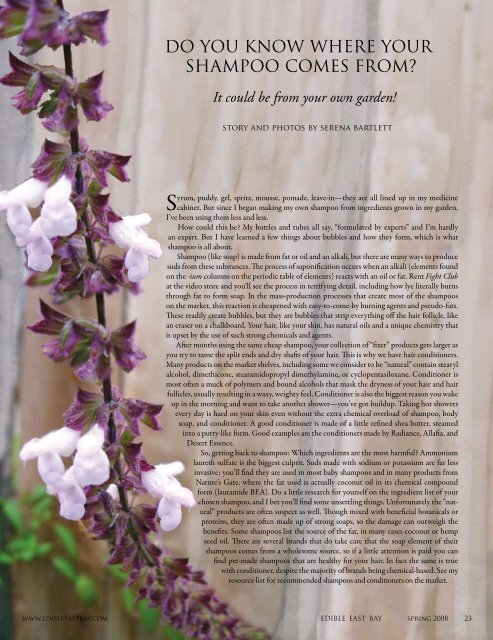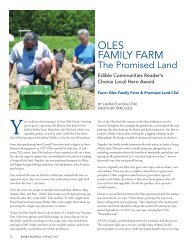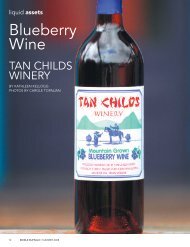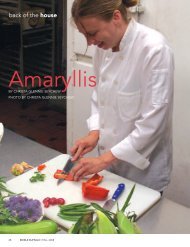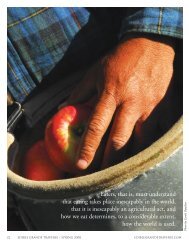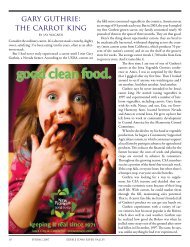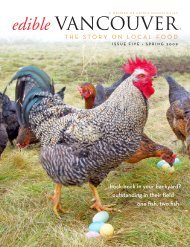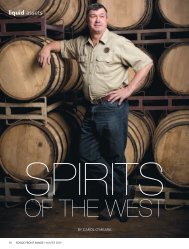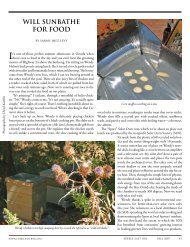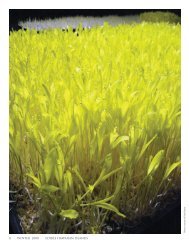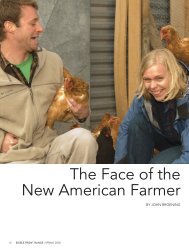DO yOU KNOW WHERE yOUR SHAMPOO COMES FROM? - Edible ...
DO yOU KNOW WHERE yOUR SHAMPOO COMES FROM? - Edible ...
DO yOU KNOW WHERE yOUR SHAMPOO COMES FROM? - Edible ...
You also want an ePaper? Increase the reach of your titles
YUMPU automatically turns print PDFs into web optimized ePapers that Google loves.
<strong>DO</strong> YOU <strong>KNOW</strong> <strong>WHERE</strong> YOUR<br />
<strong>SHAMPOO</strong> <strong>COMES</strong> <strong>FROM</strong>?<br />
It could be from your own garden!<br />
story and photos by serena bartlett<br />
Syrum, puddy, gel, spritz, mousse, pomade, leave-in—they are all lined up in my medicine<br />
cabinet. But since I began making my own shampoo from ingredients grown in my garden,<br />
I’ve been using them less and less.<br />
How could this be? My bottles and tubes all say, “formulated by experts” and I’m hardly<br />
an expert. But I have learned a few things about bubbles and how they form, which is what<br />
shampoo is all about.<br />
Shampoo (like soap) is made from fat or oil and an alkali, but there are many ways to produce<br />
suds from these substances. The process of saponification occurs when an alkali (elements found<br />
on the -ium columns on the periodic table of elements) reacts with an oil or fat. Rent Fight Club<br />
at the video store and you’ll see the process in terrifying detail, including how lye literally burns<br />
through fat to form soap. In the mass-production processes that create most of the shampoos<br />
on the market, this reaction is cheapened with easy-to-come-by burning agents and pseudo-fats.<br />
These readily create bubbles, but they are bubbles that strip everything off the hair follicle, like<br />
an eraser on a chalkboard. Your hair, like your skin, has natural oils and a unique chemistry that<br />
is upset by the use of such strong chemicals and agents.<br />
After months using the same cheap shampoo, your collection of “fixer” products gets larger as<br />
you try to tame the split ends and dry shafts of your hair. This is why we have hair conditioners.<br />
Many products on the market shelves, including some we consider to be “natural” contain stearyl<br />
alcohol, dimethicone, stearamidopropyl dimethylamine, or cyclopentasiloxane. Conditioner is<br />
most often a muck of polymers and bound alcohols that mask the dryness of your hair and hair<br />
follicles, usually resulting in a waxy, weighty feel. Conditioner is also the biggest reason you wake<br />
up in the morning and want to take another shower—you’ve got buildup. Taking hot showers<br />
every day is hard on your skin even without the extra chemical overload of shampoo, body<br />
soap, and conditioner. A good conditioner is made of a little refined shea butter, steamed<br />
into a putty-like form. Good examples are the conditioners made by Radiance, Allafia, and<br />
Desert Essence.<br />
So, getting back to shampoo: Which ingredients are the most harmful? Ammonium<br />
laureth sulfate is the biggest culprit. Suds made with sodium or potassium are far less<br />
invasive; you’ll find they are used in most baby shampoos and in many products from<br />
Nature’s Gate, where the fat used is actually coconut oil in its chemical compound<br />
form (lauramide BEA). Do a little research for yourself on the ingredient list of your<br />
chosen shampoo, and I bet you’ll find some unsettling things. Unfortunately the “natural”<br />
products are often suspect as well. Though mixed with beneficial botanicals or<br />
proteins, they are often made up of strong soaps, so the damage can outweigh the<br />
benefits. Some shampoos list the source of the fat, in many cases coconut or hemp<br />
seed oil. There are several brands that do take care that the soap element of their<br />
shampoos comes from a wholesome source, so if a little attention is paid you can<br />
find pre-made shampoos that are healthy for your hair. In fact the same is true<br />
with conditioner, despite the majority of brands being chemical-based. See my<br />
resource list for recommended shampoos and conditioners on the market.<br />
www.edibleeastbay.com EDIBLE EAST BAY spring 2008 23
If you have the time, a few bucks, and a bundle of common sense, you can follow my<br />
recipe for homemade shampoo and see if it works for you as well as it does for me. Since<br />
i discovered this formula, I stopped using conditioner very often. Sounds a bit crazy, but<br />
the liquid I boil down from a combination of herbs and flowers is what restores my outof-control<br />
frizz to shiny, manageable locks. I came up with the recipe after about a year of<br />
experimentation, and you may need to do some experimentation too, in order to find what<br />
works best for you. •<br />
Serena Bartlett is the author of the GrassRoutes Travel series of eco-travel guides. She writes<br />
about sustainability, food and travel and lives in Oakland. You can contact her directly at:<br />
sbartlett@grassroutestravel.com.<br />
how to make your own shampoo<br />
Start by gathering up some good bottles to hold your shampoo. I use plastic honey<br />
bears or repurposed product containers. You’ll find there are plenty of things that<br />
will work and you’ll soon make a habit of saving the best bottles from purchased<br />
products.<br />
The best base for what I call a “shampoo stew” is comfrey or echinacea leaves. The<br />
rough surface of the leaves melts away and the minerals and nutrients seep into the<br />
solution. Echinacea, commonly known as coneflower, is found in many California<br />
gardens. Comfrey, a blueish-flowered perennial is equally popular, but invasive. Both<br />
are considered medicinal plants. I dedicate an entire section of my garden to my shampoo<br />
ingredients, which might include sage, lemon verbena, rosemary, or the summer<br />
trimmings from my overgrown scented geraniums. Each addition has a considerable<br />
impact on the fragrance of the shampoo, even after essential oils are added.<br />
Rinse the herbs and put them in a large stockpot. Add water to cover and slowly<br />
bring the herbs to a boil. Turn heat to low and simmer for 15–20 minutes. Strain this<br />
“shampoo stew” into a large pitcher.<br />
Gather your desired soap ingredients. I use two parts Omega Nutrition soap to<br />
one part each African black soap and castile soap. Fill half of each shampoo container<br />
with shampoo stew and the other half with the soap combination of your choice.<br />
Then add 10–12 drops of tea tree oil for every 8 ounces of shampoo, another 20 or so<br />
drops of your desired fragrance, and 20 or so drops of an essential oil, such as almond,<br />
grapeseed, or neem oil. If you’re mixing a number of bottles of shampoo at once, try<br />
using several different essential oils so you can trial different versions; just remember<br />
to label the bottles accordingly. Extra shampoo stew will keep in the fridge for up to<br />
two months. Shampoo that has been mixed need not be stored in the fridge, though<br />
it is best kept out of direct sunlight.<br />
Once your shampoo is made it can be used on both body and hair. If you have<br />
longer hair, run a wide comb through it after sudsing your scalp, to get out the tangles.<br />
Try skipping conditioner after a few showers, and you might be pleasantly surprised.<br />
This stuff is great to hand out to friends or as house gifts; it is something unique that<br />
everyone, and their hair, will enjoy.<br />
Note: Castile is a general term for any soap made from vegetable oils, such as olive,<br />
coconut, almond, hemp, and jojoba. It has a very high alkalinity level, which makes it<br />
inappropriate to use alone on your hair.<br />
Mexican sage (pictured on previous page)<br />
Comfrey, scented geranium, lemon verbena, fragrant lavender (top to bottom)<br />
24 spring 2008 EDIBLE EAST BAY www.edibleeastbay.com
FINE, OILY, DRY, OR DAMAGED?<br />
As you formulate your shampoo, it’s important to examine the particular qualities of<br />
your own hair. The list below will help you choose the herbs and essential oils to add to<br />
your shampoo. Some of these grow well in East Bay gardens, so think about “growing<br />
your own shampoo”!<br />
• Sage: good for oily hair<br />
• Lemon: good for oily hair, or<br />
to lighten hair<br />
• Rosemary: (pictured here)<br />
deodorant and moisturizer;<br />
do not use if you are pregnant<br />
• Fragrant lavender: soothes<br />
nerves; good for blonde hair<br />
• Cinnamon: good for ultrastraight<br />
hair<br />
• Tea tree: good for itchy scalp,<br />
refreshing<br />
(I put it in all my shampoos)<br />
• Rosewood: expensive but<br />
nice on any type of hair,<br />
totally luxurious<br />
• Cedar: a symbol of strength,<br />
it’s great for fine hair<br />
• Eucalyptus: keeps bugs away<br />
while camping, also good for<br />
fighting dandruff<br />
• Almond: moisturizing, perfect for curly or damaged hair and smells great<br />
go FAIR TRADE for AFRICAN BEAUTY SECRETS<br />
Growing wild across the savannas of central and west Africa, is a certain tree that provides<br />
many things to the indigenous people. The bark of the shea tree is an ingredient in<br />
traditional medicines, and the shell of the nut can repel mosquitoes, but most importantly,<br />
the meat inside the shea nut, when crushed, yields an oil that is highly valued for<br />
cooking and body care.<br />
The crafting of shea butter is done by women, who also make a black soap by combining<br />
shea butter with oils from palm and cocoa, with the addition of a stew of burned<br />
leaves and bark of various trees and plants, such as banana, plantain, palm, cocoa, and<br />
shea. Each region and tribe has its own black soap recipe that has been handed down<br />
through generations.<br />
These products, along with another extraordinary oil from the neem tree, have become<br />
important exports of the region, but typically, the women who gather the raw<br />
ingredients and hand craft the products, receive only a tiny fraction of the final price<br />
we pay for them. Therefore, it is important to look for the Fair Trade label when buying<br />
shea butter products. You will be helping to empower the local communities that<br />
produce them.<br />
—CK<br />
RESOURCES<br />
Basic Ingredients and<br />
Recommended Products<br />
Berkeley Bowl<br />
2020 Oregon St., Berkeley<br />
510.843.6929<br />
www.berkeleybowl.com<br />
Elephant Pharmacy<br />
1607 Shattuck Ave., Berkeley<br />
510.549.9200<br />
www.elephantpharmacy.com<br />
Body Time<br />
1942 Shattuck Ave.<br />
510.841.5818<br />
2911 College Ave.<br />
510.845.2101<br />
www.bodytime.com<br />
Kiehl’s<br />
1848 4 th St., Berkeley<br />
510.548.0130<br />
www.kiehls.com<br />
Radiance Herbs<br />
Olympia, WA<br />
360.357.5250<br />
Alaffia<br />
www.alaffia.com<br />
Essential Oils<br />
Lhasa Karnak<br />
2482 Telegraph Ave., Berkeley<br />
510.548.0380<br />
www.herb-inc.com<br />
Plants For Your East Bay Garden<br />
East Bay Nursery<br />
2332 San Pablo Ave., Berkeley<br />
510.845.6490<br />
www.eastbaynursery.com<br />
Berkeley Horticultural Nursery<br />
1310 McGee Ave., Berkeley<br />
510.526.4704<br />
www.berkeleyhort.com<br />
Mt. Diablo Nursery and Garden<br />
3295 Mt. Diablo Blvd., Lafayette<br />
925-283-3830<br />
www.mtdiablenursery.com<br />
www.edibleeastbay.com EDIBLE EAST BAY spring winter 2008 25


